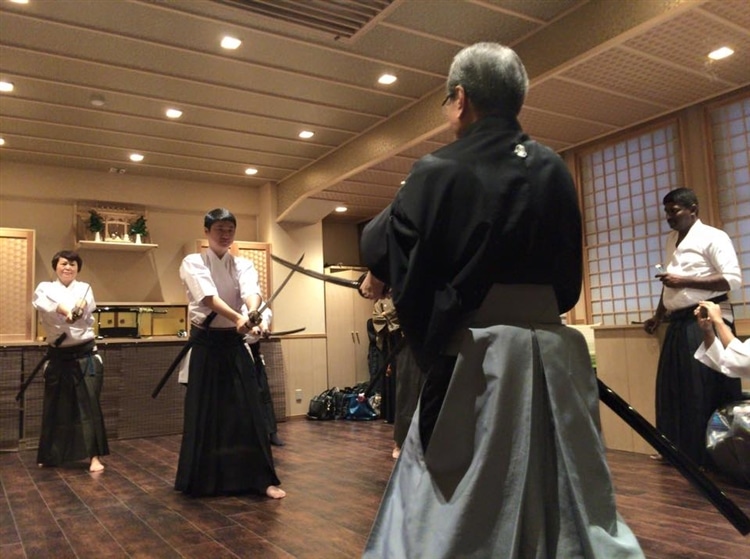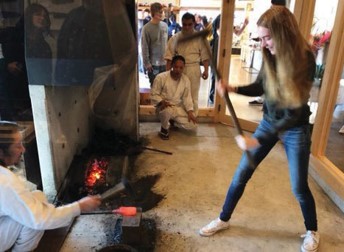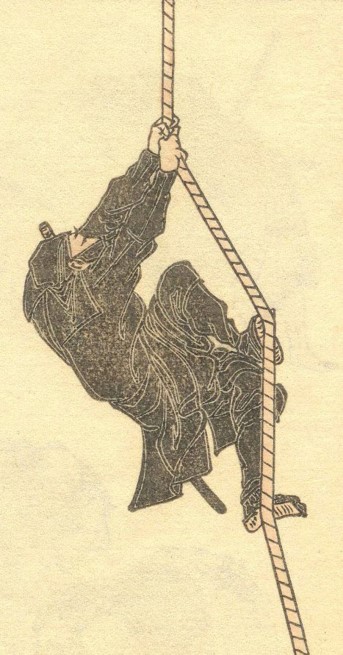
They have become, along with geisha, some of the most familiar images of traditional Japan. But like those women singers and musicians (who were not ladies of the evening), the real-life samurai and ninja are not just the characters of manga comics, games and anime movies, but fascinating figures from Japan’s martial past.
The samurai, especially, were responsible for many of the cultural treasures seen as essentially Japanese: Noh theater, ikebana flower arranging, waka traditional poetry and the tea ceremony. Even their distinguishing weapon, the katana sword, is recognized as one of the finest forms of metal craftsmanship in the world.
The ninja are a more complex matter. There aren’t that many sources that say where they actually started; it is known that they were not from the ruling classes, but emerged from the peasants who developed unique skills from their work. Today they are usually shown in black costumes, with only the eyes revealed, but this may have come from Edo-era (1603 to 1867) theater illustrations, including from famous ukiyo-e artist Hokusai, who depicted them dressed in the all-black costumes of kuroko, the stagehands who appear on stage in Kabuki and other performances to assist actors and move sets, but aren’t supposed to be noticed. It is clear that they entered popular culture during that period through the theater. While they are now seen as sneaky assassins with mystical powers, they were more often employed in infiltration, arson, ambushing, reconnaissance and bodyguarding. They were real, though, and were noted as coming from today’s Mie and Shiga prefectures.
You’ve probably encounter the stereotypes, but you can encounter both these and the real world of these famous fighters during a visit to Japan.
------------------ 01 ------------------
Become a bushi: samurai experiences
The samurai, also known (and perhaps more formally) as bushi, were the elite warrior class that existed until the changes of the Meiji era, beginning in 1867. The Chinese character for samurai means “one who waits,” and their role was to support and protect the ruler of their area. They followed a disciple called bushido, usually translated as the “way of the warrior,” but they were more than just soldiers or hired swordsmen. They were highly educated and literate, able to write in classic Chinese and fond of poetry. They were also fearsome fighters, dressed in distinctive and colorful yoroi armor, and well-practiced in the use of swords, knives and bow and arrow.
The HiSUi Tokyo cultural center provides an opportunity to experience several important aspects of the samurai culture, including sado (the tea ceremony), shodo (traditional calligraphy) and batto—using a genuine katana sword. Participants can wear the traditional hakama clothing used in training while learning how to properly swing the sword in the art of shizan, or “trial cutting.” In the Edo period, skilled swordsmen were selected to test out a new sword by cutting materials including straw or rush mats, bamboo, or even thin steel sheets. This is an experience that even most Japanese will never have.
A similar experience is available at the Kyoto Samurai and Ninja Museum. Along with displays of katana swords displayed behind glass, yoroi armor and other items are out in the open, allowing visitors to inspect the intricate craftsmanship up close. The museum also provides a samurai sword lesson by a master of the art, in which visitors wear a hakama and learn how to draw and swing the katana. They can also try tameshigiri, another name for trial cutting, using a 300-year-old sword to slice through a rolled, water-soaked tatami mat (prepared to give the same consistency as a human neck!).
Tokyo also offers a collection of katana, other swords and yoroi armor at the Japanese Sword Museum in Tokyo, one more of very few such museums in Japan.
------------------ 02 ------------------
Help hand-forge a katana sword

One of the most requested activities for many international visitors to Japan is to see the hand-forging of a samurai sword. The katana is a single-edged sword, created with a special technique involving the layering of different kinds of steel, hand-forging, quenching and carefully sharpened into an object that is as much a work of art as it is a weapon. At Sanshu, the Seki Hamon Museum in Seki City, Gifu, the 25th and 26th generations of the Kanefusa Fujiwara swordsmith family demonstrate this timeless craft. The Fujiwaras created swords for the Tokugawa family, the long-ruling shoguns of the past, and still do so for the yokozuna, the highest-ranking wrestlers in sumo, whose formal entrance to the ring is accompanied by the tachimochi, another wrestler/attendant who holds the sword vertically by the scabbard. Visitors can try their hand at swinging the forging hammer onto the red-hot metal. The museum also holds demonstrations of sword cutting, with the practitioner splitting a length of bamboo in one swift motion. Seki has long been known for the quality of the knives created here, with many fine blades available for sale.
------------------ 03 ------------------
The mysterious and mystical world of the ninja

While the real ninja remains a somewhat unknown figure—which fits with their roles as those who were supposed to be invisible, or at least not noticed—their role throughout Japanese history is known. The best-known ninja groups came from the area of Iga and Koka, now Mie and Shiga prefectures, respectively. According to Jin’ichi Kawakami, a man considered the last true Nindo (“way of the ninja”) instructor, the rural people of the region had to be self-suffient in defense, so the techniques arose not as techniques for fighting other but more focused on maintaining the peace and harmony of the villages, using the things they had available.
Mr. Kawakami comes from the Iga-ryu, the term covering the ninjutsu (ninja techniques) in the Iga/Mie region. The Ninja Museum of Igaryu, of which Kawakami-san is the honorary director, houses a wide collection of writings, displays, and more than 400 ninja tools and weapons. There are hands-on activities including weapon throwing and ninja shows.
Wear the clothes; get the skills
The Ninja Store Japan and Museum in Kyoto provides ninja training under a head instructor from Iga. Their one- and two-hour lessons go over many of the skills associated with ninja, including sword and dagger handling, shuriken (ninja star) throwing and use of a blowgun.
Also in Kyoto, the previously-mentioned Kyoto Samurai and Ninja Museum provides a similar course covering the popular ninja techniques.
A little further out from Kyoto, but well worth a visit, is the old post town of Kumagawa-juku, with many of the houses over 150 years old. It sits on the Saba Kaido, the “mackerel road” leading from the ocean in Fukui to Kyoto, and on which fish were in fact transported. In one of the old buildings is a ninja dojo run by Yuichi Niino, a woodcarver who, under the training of a ninja master and with the help of Kyoto ninja associations, began teaching here. Niino-san likes to punch a few holes in the stereotypes, saying that real ninja were more likely to wear typical peasant clothing than black in order to fit in, and probably never threw stars (although he does have a shuriken throwing area, for fun at least).
------------------ 04 ------------------
Luxury in a historic setting near the sword makers

There are samurai districts remaining in several cities across Japan, including Kanazawa, our featured destination in the previous mail magazine. Not too far from Seki City, home to the sword making Fujiwara family is the Hotel Indigo in Inuyama City, next door to beautiful, historic Inuyama Castle, the oldest structure of its type and a National Treasure of Japan. The hotel is also near to Jo-an, a 17th-century teahouse built by the younger brother of daimyo Oda Nobunaga and also a National Treasure. Look out at the tenshu tower standing high above city and the Kiso River.